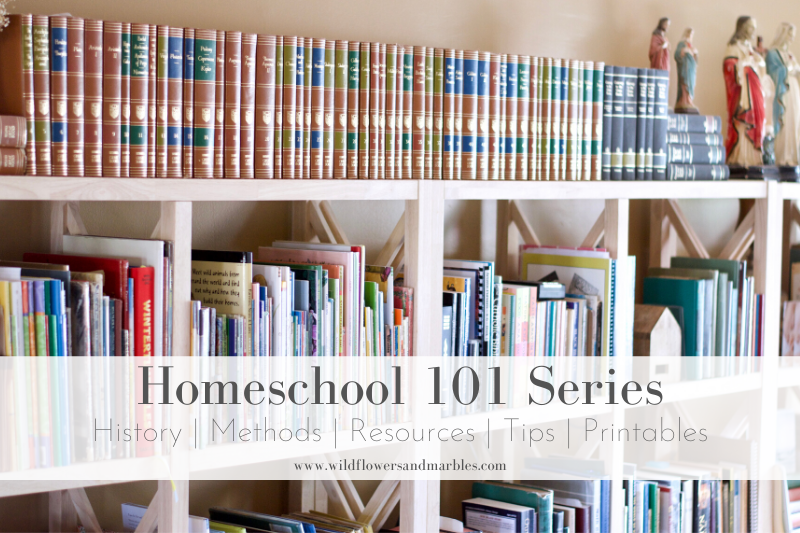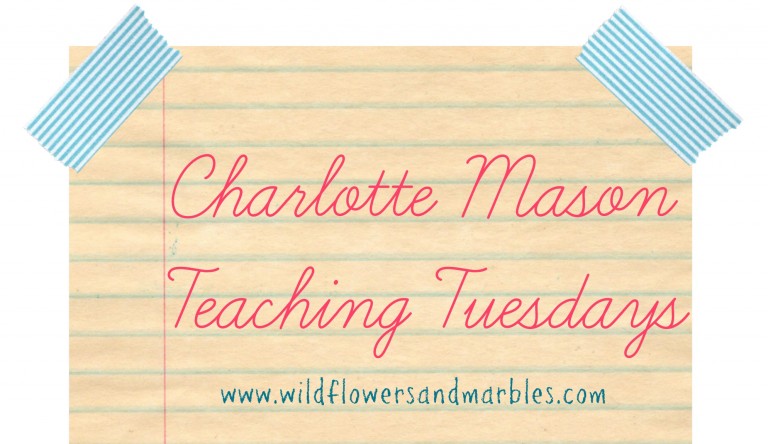Homeschooling 101 – A Simple Beginning

If you could peek into my inbox right now you’d see a plethora of inquiries about homeschooling – both particulars and general requests. I value the connection and personal communication I’m able to share with those of you that write me, but at the time of this writing, I have so many emails and requests that there is no hope for me to write to all of you individually, thus the idea for a series of posts walking you through homeschooling was born.
Homeschooling, and the volume of information, resources, and products that surround it, can be utterly overwhelming! My hope is to be a calm voice that turns down the noise, and offers you simple steps to walk your decision forward to a place of informed peace so that you can make the necessary decisions to begin – without decision paralysis or fatigue.
There is a myth, or an idyllic fantasy, that some have of homeschooling that involves romping through fields of daisies with children that then eagerly drop on a picnic blanket to beg for Algebra practice and literary analysis. And it is just that – a fantasy. Homeschooling is hard work; it is an investment of time and energy and sometimes financial resources, and the fruits aren’t guaranteed…because nothing in life is guaranteed. That’s the disclaimer, I suppose. But investments typically yield a proportional return, and that is the case with homeschooling.
What I can promise you is that from all eternity you were chosen to parent these children through this time and that you have been given all the tools you need to educate them. I can tell you that you’re going to learn alongside your children, and homeschooling is about relationships more than anything else. You’re about to embark on a journey replete with opportunities for growth, understanding, wisdom, and wonder. No other form of education possesses the unique ability and ease to meet an individual child and his needs right where that child is – met by the person who loves, knows, and understands him best in this world – and help him grow from there! Homeschooling is work, and while there are no guarantees anywhere, there is enormous potential within home education to convey ideas and provide the tools of learning for each child.
Homeschooling Begins
Homeschooling, as a movement and a viable alternative to public and private school, began in the 1970’s with John Holt, an educator who would turn education reformer after teaching for six years. He wrote the book, How Children Fail, in a response to the problems he saw in the school system and he followed up with How Children Learn three years later. Both books were very popular.
After his failed attempt to reform education within the educational system, Holt would take his observations and philosophy home. Literally. And the homeschool movement began.
50 years later, the homeschool movement continues to grow with two generations of homeschoolers now graduated. These graduates are engaging the culture, part of the workforce, starting families, some of whom are now 2nd and 3rd generation homeschoolers – educating their own children at home.
Homeschooling enjoys legal recognition (in most parts of the world), resources, conferences, speakers, encouragement, curriculum and curriculum support, and many, many veteran homeschoolers who extend their hands to help others up. It is a vast space with much room for interpretation and movement.
My own part of this story begins in my childhood by watching my mom (Carolyn Hatcher, author of Let The Authors Speak) begin homeschooling as one of the early homeschool pioneers in the 1980s. Though I wasn’t homeschooled, my siblings were, and I learned more than I realized from that peripheral perspective. I saw the transformative beauty of relationships nurtured, ideas tended, creativity encouraged, and those seeds were planted in me and found their full development in my own family – years later.
Having homeschooled my five children over the last 20+ years (I’m still homeschooling my youngest three children at the time of this writing), I now have adult children who, having graduated homeschool high school, are flourishing in following their unique God-directed paths – one is a beautiful mother who is beginning to nurture the early seeds of home education in her own home, and the other is completing an electrical engineering degree on academic scholarship. Blessings and fruit come from the imperfect, hard, wholehearted work of homeschooling.
This series will share my experience, coupled with all I observed and learned from my mom’s vast experiences – a sum total of 30 years worth of homeschool wisdom and guidance and 4 homeschool graduates (and counting)! My goal – and the goal of this series – is to share this experience with you so that you feel equipped with simple steps to begin to consider homeschooling – from the beginning.
This post in the series will couple philosophy (your “why”) with practicals (your “how”) and blend them together to help you find the homeschool road that fits your family’s journey. To help you, I’ve built a free printable to help walk you through this entire process! Click the button to view, download, and print. Grab a pen, sit down, and follow along with the printable as I walk you through the simple steps of Homeschool 101.
One thing is clear – homeschooling is exploding.
Your reasons are varied –
Some of you have have felt this pull for a while, and now is the time.
All of you were forced into homeschooling with Covid, and for some of you, that time was a catalyst that gave you the courage and push to fully explore homeschooling. Let me say this next part clearly – what you did during Covid-schooling is NOT homeschooling – it was bringing school…home. That is different from education at home. Homeschooling is flexible, efficient, gentle-when-needed, creative, relationship-building, and (when we’re not on lockdown) full of quality social time. The good news about homeschooling is you’re in charge – and you always have been. Unlike Covid-schooling, you get to choose the curriculum to meet your unique, individual kids – their strengths and weaknesses. You get to choose it with your kids in mind, with your time in mind (work-from-home-moms, here’s where you get to breathe a sigh of relief!). And you can assess reasonably, in a way that blesses.
There is another large group of you that I’m hearing from. You’re looking to build a homeschool bridge year. You’re either concerned with safety because of the Covid numbers in your local area, or you don’t want your child to sit in a room wearing a mask for 8 hours/day with limited human interaction.
There is room for all in homeschooling! The good news – homeschooling communicates a rich, full education – it gives students the tools to be lifelong learners! And it comes with the side benefit of supplementing your own education – as you teach, you learn!
This post is part of an ongoing series which is indexed here. This post may contain affiliate links which cost you nothing, but if you use the link, I may earn a small commission, for which I am very grateful!
Why are you homeschooling?
Your reasons, and my reason, for choosing homeschooling are all quite varied, and quite personal. Your “why” is so important! I’m going to ask you to spend some time prayerfully considering your why. Parents, you may only need a “why” with roots enough to get you through that bridge year. Or, you may be intrigued by the idea of homeschooling long term, but you’re still unsure about marrying this idea for 12 years (or your husband is – common!). Your “why” may be immature. All of that is fine! In articulating your “why” do your best to focus on positive reasons (that don’t involve romping through fields of daisies) to act as a foundation because your “why” is going to drive some decision making.
– use printable here –
You can be generic – “I’m homeschooling to educate my three children in a safe environment.”
Or you can get specific – “I’m homeschooling to foster relationships, creativity, and the individual strengths of each of my children using the three tools of atmosphere, discipline, and life while targeting weak areas with workable tools and stretching children in virtue and good habits. I homeschool wholeheartedly from a place of rest with the goal of educating my children so that they are equipped to virtuously engage the culture and be a part of the Conversation.
Begin to frame your “why” statement in positive terms so that you have a strong foundation to build on. Because friends, storms come. Build securely on strong foundations!
Is it Legal?
Homeschooling is legal in all 50 states of the US, Australia, Canada, and Great Britain. Worldwide, there is a variance in terms of legality – some countries allow homeschooling legally with some restrictions, and in some countries, homeschooling is illegal. I know that many of my readers are spread out across the globe, so if you’d like a breakdown of legality, check here.
Within the United States there are different laws and regulations by state – from legal compulsory age to required testing. This interactive map will allow you to select your state to find out the regulations with which you’ll need to comply.
– use printable here –
Become familiar with your state’s requirements so that you’ll know how to comply when you begin. If you find yourself more confused after looking at the laws for your state, start searching for local homeschool groups and get to know other moms. Veteran homeschool moms are an incredible homeschool resource! Facebook is a great place to start for this or you can look for a group here.
How will you homeschool?
Step 1, 2, 3 – why, how, what. In that order.
I’ve spoken to homeschoolers who jump directly from the “why” of homeschooling to the “what” – or just directly to “what” with no “why” at all. To do so is to miss a very important step in the process – “how.” Skipping steps in this process may result in burnout, or at the very least overwhelm.
This “how” question is so important – it’s the road you’ll take with a view toward educating your children. Skipping this step would be like taking a journey and setting off to the west with an eventual destination and no clue how to get there. And if you skip this “how” step and go directly to the “what” – the curriculum and books and things which are the vehicle of home education – and start choosing those before knowing your “how,” it would be analogous to taking your journey and purchasing a boat but not knowing if your journey takes you over water, land, or air. Know your road (how/homeschool method) so you can choose the most efficient vehicle (what/homeschool books, curriculum, things) to reach your destination – education.
“How” involves homeschool philosophy, style, and method, and though you don’t have to have a masters in education here, you are going to need a willingness to spend some time and do a little reading and research as well as some honest examinations of your strengths and weaknesses, and a consideration of an educational philosophy/style that resonates with your family culture and values.
– use printable here –
The Homeschooling Methods
Before we dive into these, I should state up front that there are actually many methods of homeschooling your kids. The following have sifted out over the years as popular, have longevity, resources, and have borne fruit.
- Unschooling
- Charlotte Mason Home Education
- Classical Home Education
- Neo-Classical Home Education
- School-in-a-Box |Pre-packaged | All-in-one Curriculum
- Montessori at Home
- Unit Study
- Eclectic/Relaxed Home Education
Because each of these deserve some explanations along with a listing of pros/cons and resources, I’m going to spend the entire next post in this series sharing information and resources about each of these methods so you can begin to consider your “how” – your map and the vehicle (“what”/curriculum) you’ll choose.
Your homework – use the Homeschool 101 printable and:
- Define your homeschool “why”
- Know your state’s homeschool laws and regulations so you can work within them
- Know “how” you will homeschool by discerning the homeschool methods and choosing the one that fits you, your kids, your family, and your season best.
- Embrace your superpower – flexibility!
Watch for the next post in the Homeschool 101 series – Homeschool Methods – very soon! And following that post, there will be a post covering all of the most common homeschool questions along with my answers.







Like all your posts, this latest one is so encouraging and insightful – I find myself always coming away smiling, more confident and excited. I had to share it with my local homeschool group. THANK YOU!
We have used Let the Authors Speak for years through the curriculum we use, St. Thomas Aquinas! It’s one of the highly recommended books for good literature selections. I can’t believe that is your mom! That is just too cool. No wonder I just love you:) Thanks for the post. We have been homeschooling for many years and I learned a lot today!